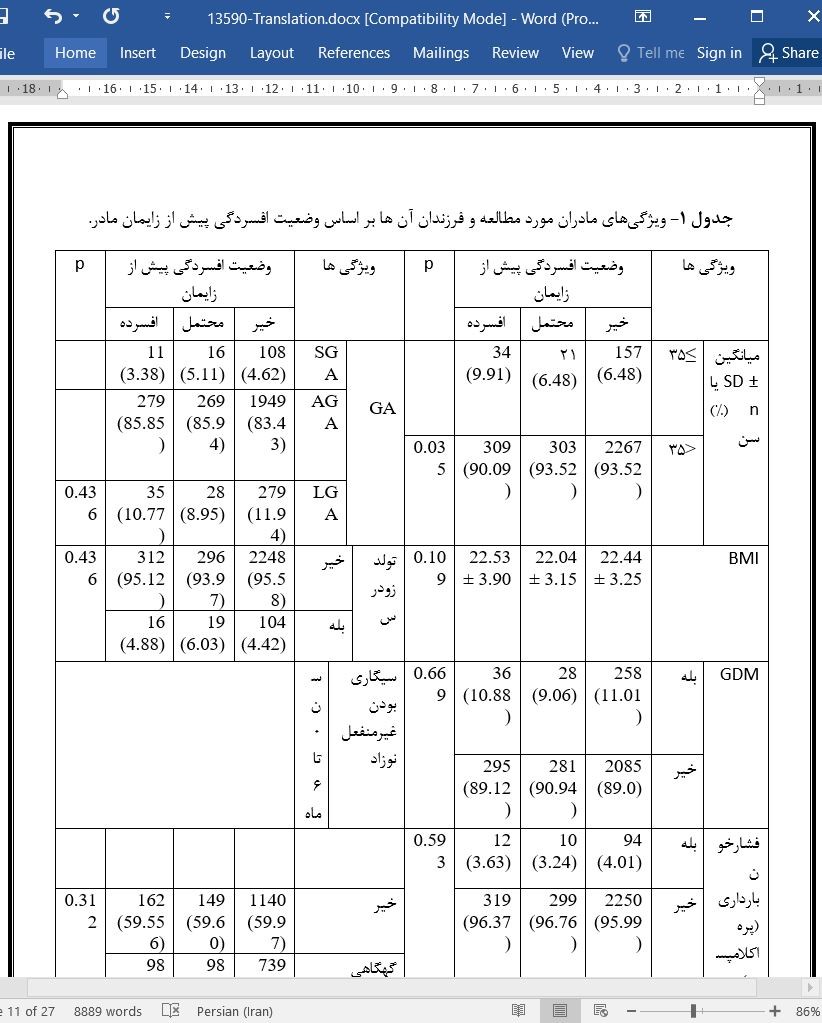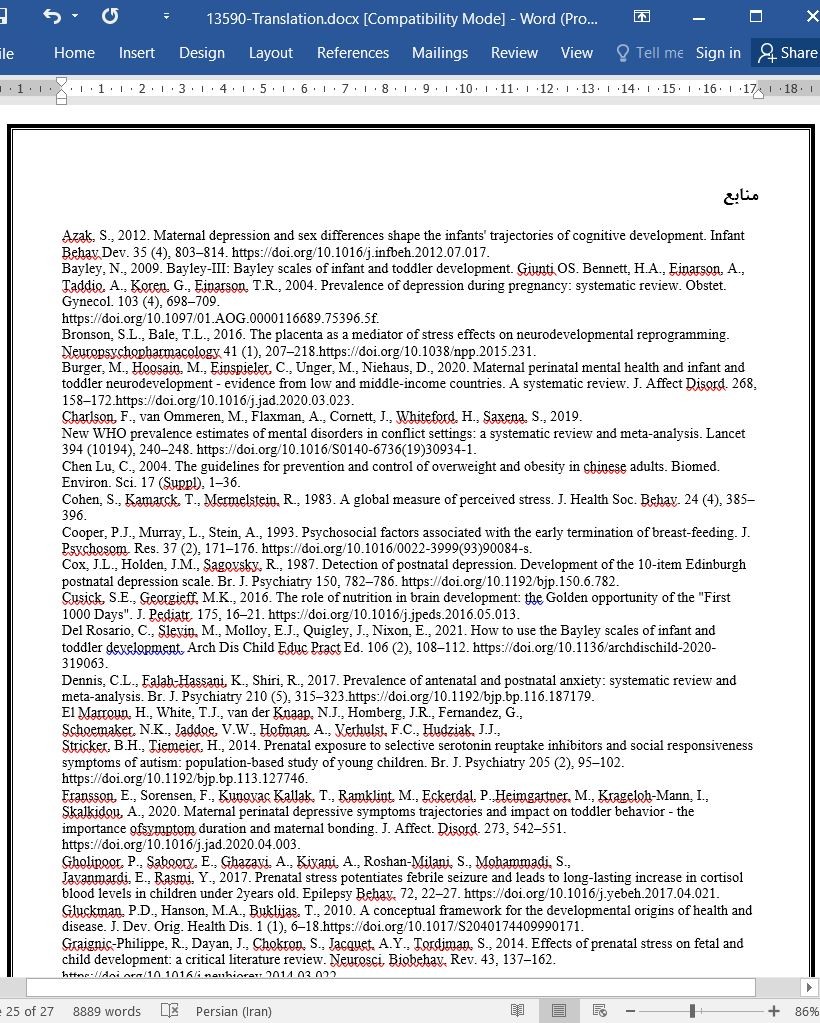
دانلود مقاله تاثیر افسردگی، اضطراب و استرس مادر بر رشد عصبی اولیه در نوزاد ان پسر و دختر
چکیده
هدف مطالعه: بررسی اثرات افسردگی، اضطراب و استرس مادر و افسردگی پس از زایمان بر رشد اولیه سیستم عصبی نوزاد و دو دیسی جنسی.
طراحی مطالعه: از دادههای 3379 جفت مادر-شیرخوار از مطالعه همگروهی تولد شانگهای استفاده شد. سلامت روان مادر با استفاده از مقیاس افسردگی مرکز مطالعات اپیدمیولوژیک، مقیاس خود ارزیابی اضطراب زونگ، مقیاس استرس ادراک شده در اواسط بارداری و مقیاس افسردگی پس از زایمان ادینبرگ ارزیابی شد. رشد عصبی نوزاد با استفاده از پرسشنامه سن و مراحل و مقیاس بیلی به ترتیب در سنین 6، 12 و 24 ماهگی مورد بررسی قرار گرفت. از مدل های خطی مختلط و مدل های رگرسیون خطی استفاده شد.
نتایج: از بین 3379 مادر، 11.07 درصد، 5.42 درصد و 34.85 درصد زنان به صورت جداگانه افسردگی، اضطراب و استرس بالا را تجربه کردند. با افزایش امتیازات ذهنی قبل از تولد مادر در هر 1 انحراف معیار، نمرات اجتماعی عاطفی نوزاد در بین نوزادان پسر و دختر در سن 24 ماهگی، به ترتیب به شکل زیر کاهش یافت: افسردگی 2.82 - (1.79 - 3.86 -) در مقایسه با 2.86 - (1.79 - 3.94 -)، اضطراب 2.34 - (1.31 - 3.38 -) در مقایسه با 2.72 - (1.64 - 3.81 -) و استرس 2.55 - (1.50 - 3.60 -) در مقایسه با 3.41 - (2.35 - 4.48 -). همچنین ارتباطاتی بین امتیازات اجتماعی-عاطفی و ارتباطی در نوزادان پسر و دختر و حرکات ظریف در نوزادان دختر در سنین 6 و 12 ماه مشاهده شد. این ارتباط در مورد افسردگی پس از زایمان مشاهده نشد.
محدودیت ها: تعمیم دادن نتایج به سایر جمعیت ها هنوز مشخص قابل انجام نیست.
نتیجه گیری: افسردگی، اضطراب و استرس قبل از تولد مادر با رشد عصبی اولیه نوزاد ارتباط منفی داشت که البته برای افسردگی پس از زایمان مشاهده نشد. بر اساس این نتایج، بر اهمیت سلامت روان قبل از تولد مادر در بهینه سازی رشد عصبی-روانی نوزاد تاکید می کنیم.
1. مقدمه
1000 روز اول زندگی برهه ای حیاتی برای رشد عصبی بوده (Cusick and Georgieff, 2016; Schwarzenberg et al., 2018) که به عوامل مادری و محیط نامطلوب اولیه حساس است (Suzuki,2018). اختلالات روانی سهم مهمی در بار کلی بیماری در دنیا دارند (Charlson et al., 2019). بیماری روانی پره ناتال تحت عنوان اختلالات روانپزشکی مادری که قبل از بارداری وجود داشته و ادامه دارد، یا در دوران بارداری و یا در دوره پس از زایمان ظاهر شده است، تعریف می شود (O'Hara and Wisner, 2014). بروز افسردگی 12.8 - 7.4 درصد (Bennett et al., 2004) و بروز اضطراب 24.6 - 18.2 درصد در میان زنان باردار بود (Dennis et al., 2017). مشکلات مادر در دوران بارداری ممکن است با ایجاد اختلال در محور هیپوتالاموس-هیپوفیز-آدرنال (HPA) و اختلال در ساختارها و عملکردهای عصبی جنین، سطوح کورتیکوئید جنینی را افزایش دهد (Bronson and Bale, 2016; Gluckman et al., 2010; O'Donnell and Meaney, 2017). مطالعات پیشین گزارش کردند که بیماری های روانی مادر در دوران بارداری، از جمله افسردگی (Rogers et al., 2020) ، اضطراب (Rees et al., 2019) و استرس ادراک شده (Graignic-Philippe et al., 2014) ، با رشد عصبی نامطلوب نوزاد در زبان (Rogers et al., 2020) ، شناخت (Wu et al., 2022) ، حرکت (Simcock et al., 2018) ، رفتار انطباقی (Rogers et al., 2020) یا صلاحیت اجتماعی-عاطفی (Porter et al., 2019) مرتبط است. با این وجود در مقایسه انواع مشکلات روانی قبل و پس از زایمان مادران با موارد مختلف رشد عصبی نوزاد، این ارتباط کمتر مشهود بود (Burger et al., 2020) . اغلب مطالعات پیشین از ارزیابی خودگزارشی رشد کودک و ابزارهای محدودی برای در نظر گرفتن تفاوت های جنسی نوزادان در رشد اولیه کودک (Azak, 2012; Simcock et al., 2018) یا واسطه گری احتمالی افسردگی پس از زایمان (Lahti et al., 2017) ، به ویژه در کشورهای کم درآمد و درآمد متوسط (LAMICs) استفاده کردند (Burger et al., 2020).
5. نتیجه گیری
مشکلات روانی پیش از زایمان مادر با رشد عصبی اولیه کمتر بهینه نوزاد نظیر صلاحیت های عاطفی-اجتماعی، مهارت های ارتباطی، شناختی و حرکتی در 2 سال اول زندگی همراه بود و تأثیرات زیادی بر رشد اجتماعی-عاطفی در نوزادان پسر و دختر داشت. دوره پیش از زایمان، پنجره ای مهم برای تأثیر افسردگی مادر بر رشد عصبی نوزاد است. افسردگی پس از زایمان واسطه گری و اثرات محدودی داشت. این مطالعه بر اهمیت مداخله در احساسات مادران در دوران بارداری برای بهینه سازی عصب-روانپزشکی کودک تاکید می کند.
Abstract
Objective To examine the effects of prenatal maternal depression, anxiety and stress, and postnatal depression on infant early neurodevelopment, and the sex dimorphism.
Study design We used data from 3379 mother-infant pairs from the Shanghai Birth Cohort. Maternal mental health was assessed using the Center for Epidemiological Studies-Depression Scale, Zung Self-Rating Anxiety Scale, Perceived Stress Scale at mid-pregnancy, and the Edinburgh Postnatal Depression Scale at postpartum. Infant neurodevelopment was evaluated using the Ages & Stages Questionnaires and Bayley Scales at ages 6, 12, and 24 months, respectively. Linear mixed models and linear regression models were used.
Results Among 3379 mothers, 11.07 %, 5.42 %, and 34.85 % of women experienced depression, anxiety, and elevated stress, separately. As maternal prenatal mental scores increased per 1SD, infant social-emotional scores decreased −2.82 (−3.86, −1.79) vs −2.86 (−3.94, −1.79) for depression, −2.34 (−3.38, −1.31) vs −2.72 (−3.81, −1.64) for anxiety, and −2.55 (−3.60, −1.50) vs −3.41 (−4.48, −2.35) for stress among boys and girls at age 24 months, respectively. Associations were also observed on social-emotional and communication scores in boys and girls, and fine motor in girls at age 6 and 12 months. These associations were not observed for postpartum depression.
Limitation Generalizability of the results to other population remains to be determined.
Conclusions Prenatal maternal depression, anxiety, and stress were negatively associated with infant early neurodevelopment, which were not observed for postpartum depression. We underscore the importance of maternal prenatal mental health in optimizing infant neuropsychiatric development.
1. Introduction
The first 1000 days of life are a critical period for neurodevelopment (Cusick and Georgieff, 2016; Schwarzenberg et al., 2018), and are sensitive to maternal factors and an adverse early environment (Suzuki, 2018). Mental disorders are an important contributor to the overall burden of 04disease in the world (Charlson et al., 2019). Perinatal mental illness was defined as maternal psychiatric disorders that existed before and persisting into pregnancy, or emerged during pregnancy, or in the postpartum period (O'Hara and Wisner, 2014). Depression affected 7.4–12.8 % (Bennett et al., 2004) of pregnant women, while anxiety affected 18.2–24.6 % (Dennis et al., 2017) of pregnant women. Prenatal maternal adversities might increase fetal corticoid levels by interrupting hypothalamic-pituitary-adrenal (HPA) axis, and “program” impaired fetal neural structures and functions (Bronson and Bale, 2016; Gluckman et al., 2010; O'Donnell and Meaney, 2017). Previous studies had reported that maternal perinatal mental illnesses, including single or combined depression (Rogers et al., 2020), anxiety (Rees et al., 2019) and perceived stress (Graignic-Philippe et al., 2014), were associated with adverse infant neurodevelopment in language (Rogers et al., 2020), cognitive (Wu et al., 2022), motor (Simcock et al., 2018), adaptive behavior (Rogers et al., 2020) or social-emotional (Porter et al., 2019) competences. However, the associations were less evident when comparing the types of prenatal and postpartum maternal mental problems with different domains of infant neurodevelopment domains (Burger et al., 2020). Most previous studies used self-report evaluation of child development and limited tools to take into account infant sex differences in early child development (Azak, 2012; Simcock et al., 2018) or possible mediation of postpartum depression in associations (Lahti et al., 2017), especially in low and middle income countries (LAMICs) (Burger et al., 2020).
5. Conclusion
Prenatal maternal mental problems were associated with less optimal infant early neurodevelopment including social-emotional, communication, cognition, and motor competences in the first 2 years, with strong effects on social-emotional development in both boys and girls. The sex modification effect appeared in the associations. Prenatal period is an important susceptible window for the effect of maternal depression on infant neurodevelopment. Postpartum depression had limited mediation and joint effects. This study underscores the importance of intervention in mothers' emotions during pregnancy to optimize child neuropsychiatric.
چکیده
1. مقدمه
2. روش ها
2.1 طراحی مطالعه و شرکت کنندگان
2.2 ارزیابی سلامت روان مادر
2.3 ارزیابی رشد عصبی در کودکان
2.4 عوامل مخدوش کننده بالقوه
2.5 تجزیه و تحلیل آماری
3. نتایج
3.1 جمعیت مطالعه
3.2 افسردگی پیش از تولد مادر و رشد عصبی نوزاد
3.3 اضطراب پیش از زایمان مادر و رشد عصبی نوزاد
3.4 استرس ادراک شده پیش از زایمان مادر و رشد عصبی نوزاد
3.5 افسردگی پس از زایمان مادری و رشد عصبی نوزاد
3.6 اثر واسطه گری افسردگی پس از زایمان مادر
4. بحث
5. نتیجه گیری
منابع
Abstract
1. Introduction
2. Methods
2.1. Study design and participants
2.2. Assessments of maternal mental health
2.3. Assessment of neurodevelopment in children
2.4. Potential confounders
2.5. Statistical analysis
3. Results
3.1. Study population
3.2. Prenatal maternal depression and infant neurodevelopment
3.3. Prenatal maternal anxiety and infant neurodevelopment
3.4. Prenatal maternal perceived stress and infant neurodevelopment
3.5. Postpartum maternal depression and infant neurodevelopment
3.6. Mediation effect of maternal postpartum depression
4. Discussion
5. Conclusion
Funding
Acknowledgments
References
این محصول شامل پاورپوینت ترجمه نیز می باشد که پس از خرید قابل دانلود می باشد. پاورپوینت این مقاله حاوی 16 اسلاید و 5 فصل است. در صورت نیاز به ارائه مقاله در کنفرانس یا سمینار می توان از این فایل پاورپوینت استفاده کرد.
در این محصول، به همراه ترجمه کامل متن، یک فایل ورد ترجمه خلاصه نیز ارائه شده است. متن فارسی این مقاله در 6 صفحه (1680 کلمه) خلاصه شده و در داخل بسته قرار گرفته است.
علاوه بر ترجمه مقاله، یک فایل ورد نیز به این محصول اضافه شده است که در آن متن به صورت یک پاراگراف انگلیسی و یک پاراگراف فارسی درج شده است که باعث می شود به راحتی قادر به تشخیص ترجمه هر بخش از مقاله و مطالعه آن باشید. این فایل برای یادگیری و مطالعه همزمان متن انگلیسی و فارسی بسیار مفید می باشد.
بخش مهم دیگری از این محصول لغت نامه یا اصطلاحات تخصصی می باشد که در آن تعداد 45 عبارت و اصطلاح تخصصی استفاده شده در این مقاله در یک فایل اکسل جمع آوری شده است. در این فایل اصطلاحات انگلیسی (تک کلمه ای یا چند کلمه ای) در یک ستون و ترجمه آنها در ستون دیگر درج شده است که در صورت نیاز می توان به راحتی از این عبارات استفاده کرد.
- ترجمه فارسی مقاله با فرمت ورد (word) با قابلیت ویرایش و pdf بدون آرم سایت ای ترجمه
- پاورپوینت فارسی با فرمت pptx
- خلاصه فارسی با فرمت ورد (word)
- متن پاراگراف به پاراگراف انگلیسی و فارسی با فرمت ورد (word)
- اصطلاحات تخصصی با فرمت اکسل



